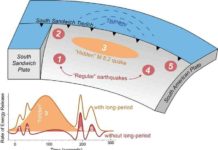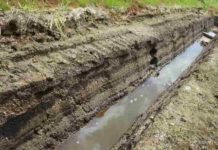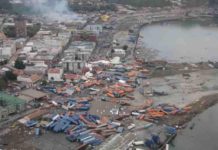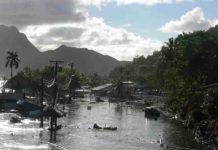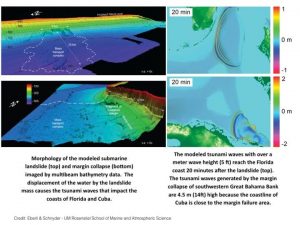
Credit: Eberli & Schnyder – UM Rosenstiel School of Marine and Atmospheric Science
While the Caribbean is not thought to be at risk for tsunamis, a new study by researchers at the University of Miami (UM) Rosenstiel School of Marine and Atmospheric Science indicates that large submarine landslides on the slopes of the Great Bahama Bank have generated tsunamis in the past and could potentially again in the future.
“Our study calls attention to the possibility that submarine landslides can trigger tsunami waves,” said UM Rosenstiel School Ph.D. student Jara Schnyder, the lead author of the study. “The short distance from the slope failures to the coastlines of Florida and Cuba makes potential tsunamis low-probability but high-impact events that could be dangerous.”
The team identified margin collapses and submarine landslides along the slopes of the western Great Bahama Bank — the largest of the carbonate platforms that make up the Bahamas archipelago — using multibeam bathymetry and seismic reflection data. These landslides are several kilometers long and their landslide mass can slide up to 20 kilometers (12 miles) into the basin.
An incipient failure scar of nearly 100 kilometers (70 miles) length was identified as a potential future landslide, which could be triggered by an earthquake that occasionally occur off the coast of Cuba.
Using the mathematical models commonly used to evaluate tsunami potential in the U.S., the researchers then simulated the tsunami waves for multiple scenarios of submarine landslides originating off the Great Bahama Bank to find that submarine landslides and margin collapses in the region could generate dangerous ocean currents and possibly hazardous tsunami waves several meters high along the east coast of Florida and northern Cuba.
“Residents in these areas should be aware that tsunamis do not necessarily have to be created by large earthquakes, but can also be generated by submarine landslides that can be triggered by smaller earthquakes,” said UM Rosenstiel School Professor of Marine Geosciences Gregor Eberli, senior author of the study.
The study, titled “Tsunamis caused by submarine slope failures along western Great Bahama Bank,” was published in the Nov. 4 issue of the journal Scientific Reports. The paper’s co-authors include: Jara S.D. Schnyder, Gregor P. Eberli of the CSL-Miami, James T. Kirby, Fengyan Shi, and Babak Tehranirad of the University of Delaware, Thierry Mulder and Emmanuelle Ducassou of the Université de Bordeaux in France, and Dierk Hebbeln and Paul Wintersteller of the University of Bremen in Germany.
Reference:
Jara S.D. Schnyder, Gregor P. Eberli, James T. Kirby, Fengyan Shi, Babak Tehranirad, Thierry Mulder, Emmanuelle Ducassou, Dierk Hebbeln, Paul Wintersteller. Tsunamis caused by submarine slope failures along western Great Bahama Bank. Scientific Reports, 2016; 6: 35925 DOI: 10.1038/srep35925
Note: The above post is reprinted from materials provided by University of Miami Rosenstiel School of Marine & Atmospheric Science.






